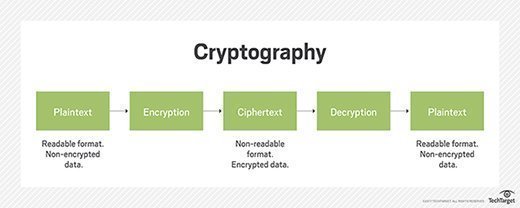Cryptography is the science of protecting information through the use of codes and systems. The most basic form of cryptography is encryption. Encryption is the process of encoding a message in such a way that only those who have the correct decryption key can read the message. The most common application of cryptography is digital signatures.
In simple terms, cryptography is the study of ways to protect information and information systems. It involves using advanced math and computer science to protect sensitive data and information from unauthorized access, use, or disclosure. Cryptography is used to secure data in transit, at rest, in the cloud, and on your devices.

Table of Contents
Types of Ciphers
Conventionally, there are two types of ciphers. They are the following:
Substitution ciphers
Substitution ciphers are a very simple but effective way to encrypt text. The encryption and decryption are done by replacing certain characters in the plain text with other characters. This is a very simple concept, but it can be surprisingly effective when applied to larger blocks of text. In this video, we’ll look at how substitution ciphers work and how you can set up a simple substitution cipher in Python.
One of the oldest known ciphers is the Caesar Cipher, attributed to Julius Caesar. For example, using this cipher, attack becomes DWWDFN. Here plaintext is in lowercase and cipher text in uppercase letters. A slight generalisation of the Caesar cipher allows the cipher text alphabet to be shifted by k letters, instead of always 3. In this case k becomes a key to the general method of circularly shifted alphabets. Example in Fig. I shows:
Also Read:Security Issues/Breaches In Cyber Space (Cyber Security and law)
JULIUSCAESAR Plaintext
EFGEFGEFGEFG Key EFG repeated
1021 12 09 21 19 03 01 05 19 01 18 Plaintext, numeric
05 06 07 05 06 07 05 06 07 05 06 07 Key EFG, numeric
15 19 11 12 19 20 06 07 02 22 07 21 Cipher text (Plain XOR key)
A ONE-TIME PAD
One-time pad ciphers are unbreakable because they give no information to the cryptanalyst. The primary difficulty with one-time pad is that the key must be as long as the message itself, so key distribution becomes a problem, since a different pad must be used for each communication.
Transposition Ciphers:
It operates by reordering the plaintext symbols, whereas substitution ciphers preserve the order of the plaintext symbols but try to disguise them. An example of its Columnar transposition is described below:
CONSULT Keyword
1435726 Column numbers
ENCRYPT Plaintext:
IONISPE ENCRYPTIONSPERFORMEDBYWRITINGTHEPLAINTEXT R FORMED
BYWRITI
NGTHEPL cipher text:
AINTE X TEIRBNAPPETPXCNOWINNOFYGIRIRRHTTEDILTYSMIEE
FIGURE for Transposition Cipher.
The other types of ciphers which are present are as follows: (The Economic Times, 2021, p.1)
Polyalphabetic substitution cipher:
In this cipher, a blended alphabet is utilized to encrypt the plaintext, but at random points it would convert to a special uncommon mixed alphabet which denotes the alteration with an uppercase letter in the Ciphertext.
Transposition Cipher:
This cipher is also known as Rail Fence Cipher and is a permutation of the plaintext.
Permutation Cipher:
The locations assumed by plain text are moved to a uniform system in this cipher so that the cipher text amounts to a permutation of the plaintext.
Private-key Cryptography:
In this cipher, even the attacker is mindful of the plaintext and corresponding ciphertext. The sender and receiver must have a pre- shared key. The shared key is kept undisclosed from all other parties and is used for encryption as well as decryption. DES and AES algorithms are examples of this type of cipher. This cryptography is also known as “symmetric key algorithm”.
Public-key Cryptography:
In this cipher, two different keys – public key and private key-are used for encryption and decryption. The sender uses the public key to carry out encryption, whereas the receiver is kept in the dark about the private key. This is also known as asymmetric key algorithm.
Functions of Cryptography
Base cryptographic functions provide the most flexible means of developing cryptography (cipher) applications. All communication with a cryptographic service provider (CSP) occurs through these functions ACSP is an independent module that performs all cryptographic operations. At least, one CSP is needed with each application that uses cryptographic functions. A single application can occasionally use more than one CSP. Base cryptographic functions are in the following broad group
Service provider function
Key generation and exchange function
Object encoding and decoding functions
Data Encryption and decryption functions
Hash and Digital functions
The five key functions of cryptography are: (Gary C. Kessler, 2021, p. 1)
Also Read:Cyber Security Issues And Challenges
- Privacy/Confidentiality: Making sure that no one can peruse the message except the intended receiver.
- Authentication: The process of showing and establishing one’s identity.
- Integrity: Assuring the receiver that the received message has not been
distorted in any manner from the initial.
- Non-repudiation: A process or a way to prove that the sender really sent this
message.
- Key exchange: The approach by which crypto keys are shared between sender
and receiver.





